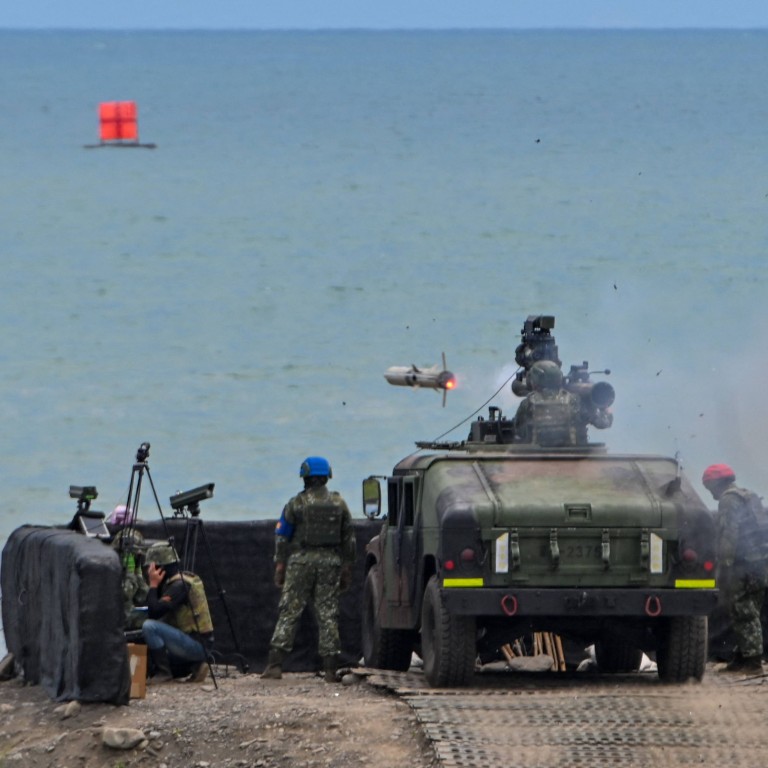
US approves US$345 million landmark military aid package for Taiwan
- The supplies of unspecified weapons will come from American stockpiles and be transferred under the presidential drawdown authority
- The authority has been used in the past to channel military aid to Ukraine
It is the first package of its kind since Washington switched official recognition to Beijing from Taipei in 1979 and follows repeated requests by Congress in the past few years.
“By the authority vested in me as president … I hereby delegate to the secretary of state the authority … to direct the drawdown of up to US$345 million in defence articles and services … and military education and training, to … Taiwan,” Joe Biden said on Friday.
The authority allows the president to swiftly transfer articles and services from American stockpiles under the US Foreign Assistance Act of 1961.
It is the first time it has been used to transfer weapons and military aid to Taiwan.
As a part of the 2023 budget, the US Congress authorised up to US$1 billion in military aid to Taiwan via the drawdown authority, a decision Beijing attacked at the time.
The package is in addition to US$10 billion in no-interest loans for Taiwan.
According to the secretary of state, the drawdown this time included “defence articles and services of the Department of Defence, and military education and training, to … Taiwan”.
The foreign ministry in Beijing had not commented on the decision by Saturday afternoon.
Wang Kung-yi, head of the Taiwan International Strategic Study Society, a Taipei think tank, said the move was expected to further anger Beijing.
“The mainland is already upset by US arms sales to Taiwan and it is expected to react with stronger action over the free weapons to Taipei,” Wang said.
Liu Pengyu, a spokesman for China’s embassy in Washington, said in a statement on Friday that Beijing “firmly opposed” US military ties with Taiwan.
The US should “stop selling arms to Taiwan” and “stop creating new factors that could stoke tensions in the Taiwan Strait”, he said.
Taiwan has complained about frequent US delays in weapon deliveries to the island – a situation that it says could increase the risk to the self-ruled island from mainland China’s rapid military expansion and sabre rattling.
Members of the US Congress have been pushing the Biden administration to accelerate those deliveries, with House Representative Young Kim saying in February at that Washington had run up a backlog of US$21 billion worth of defence items it had agreed to sell Taiwan.
Li Da-jung, a professor of international relations and strategic studies at Tamkang University in New Taipei City, said Taiwan usually had to wait years for American suppliers to fill the orders and deliver them.
“If the delivery comes too late, Taiwan might not have the weapons it most needs to defend itself in the event of a cross-strait war,” he said.
In April, deputy defence secretary Kathleen Hicks said that one of the lessons the US had learned from Russia’s invasion of Ukraine was the need to get stockpiles of weapons to Taiwan before it faced attack.
Beijing views Taiwan as its territory that must be brought under its control, by force if necessary, though it has repeatedly said it wants to resolve the situation peacefully.
Military activities also increased in April after Taiwanese President Tsai Ing-wen met Pelosi’s successor, Kevin McCarthy, in California. Beijing viewed the moves as a major breach of its sovereignty.
Su Tzu-yun, a senior analyst at the Institute for National Security Research, a government think tank, said that due to a tacit understanding between the two sides, the US did not reveal what was in the package.
“This can also avoid making public what weapons the US has in its current stockpiles and what items Taiwan would use to defend itself,” Su said, adding such a move was a kind of strategic ambiguity to keep Beijing guessing.
According to a Reuters report, the package could include four unarmed MQ-9A Reaper reconnaissance drones, which are different from four more advanced MQ-9B SeaGuardian drones Taiwan planned to buy from the US.
The aid package is not related to previous arms sales approved by the US, which in late June agreed to sell US$440 million worth of spare parts as well as logistical support that would help Taiwan maintain its armoured vehicles, small arms and combat weapon systems.
In March, Washington also approved US$619 million worth of munitions and related equipment for the island’s fleet of F-16V fighter jets.



